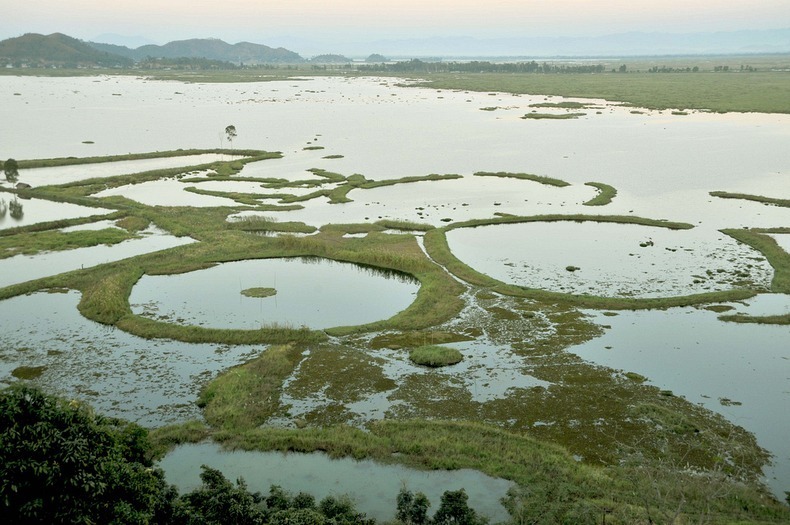Floating Phumdis of Loktak Lake, India
Loktak Lake is the largest freshwater lake in northeast India, also called the only Floating lake in the world due to the large amount of floating phumdis on its surface. Phumdis are heterogeneous mass of vegetation, soil, and organic matters at various stages of decomposition that has been thickened into a solid form. They cover a substantial part of the lake area. The largest single mass of phumdi is in the southeastern part of the lake, covering an area of 40 square kilometer. This mass constitutes the world’s largest and the only floating park, named Keibul Lamjao National Park, that is home to the endangered Brow-antlered Deer also called Sangai in the Manipuri language, indigenous to this area. This ancient lake plays an important role in the economy of Manipur. It serves as a source of water for hydropower generation, irrigation and drinking water supply. The lake is also a source of livelihood for the rural fisherman who live in the surrounding areas and on phumdis, also known as “phumshongs”. Phumdis are used by the local people for constructing huts, for fishing and other livelihood uses. The villagers create artificial circular enclosures out of phumids for fish farming. These are the structures you see in the picture below. Nearly 100,000 people depends on the lake for their livelihood.

Photo credit
Based on the presence or absence of phumids and the pressure of human activities, the lake is broadly divided into northern, central and southern zones. The northern zone is separated from the central zone by large phumdis of varying thickness between 0.4 to 4.5 meters that stretches from the northwest to the southeast. During January to March, phumdis in this area are usually burnt for construction of fish cum paddy farms.
The Central Zone is the main open water zone of the lake, which was relatively free from phumdis in the past, but over the years villagers have constructed artificially created phumdis for fishing, called 'athaphums'. These have proliferated choking the entire lake. The Keibul Lamjao National Park lies in the southern zone.
Loktak lake has a rich biodiversity with 233 species of aquatic plants. More than a hundred species of birds live in the lake, and 425 species of animals including rare animals such as the Indian python, sambhar and barking deer.
Loktak lake is located 39 km from Imphal, the capita city of Manipur which is well connected by road and air. The lake is a unique destination for tourism, offering visitors excellent opportunity to enjoy the beauty of the lake and its several islands of floating phumdis of different geometrical shapes. The Sendra Tourist Home itself is located on a large Phumdi in Loktak Lake.

Photo credit

Photo credit

Photo credit

Photo credit

Photo credit

Photo credit

Photo credit

Photo credit

Photo credit

Photo credit
Based on the presence or absence of phumids and the pressure of human activities, the lake is broadly divided into northern, central and southern zones. The northern zone is separated from the central zone by large phumdis of varying thickness between 0.4 to 4.5 meters that stretches from the northwest to the southeast. During January to March, phumdis in this area are usually burnt for construction of fish cum paddy farms.
The Central Zone is the main open water zone of the lake, which was relatively free from phumdis in the past, but over the years villagers have constructed artificially created phumdis for fishing, called 'athaphums'. These have proliferated choking the entire lake. The Keibul Lamjao National Park lies in the southern zone.
Loktak lake has a rich biodiversity with 233 species of aquatic plants. More than a hundred species of birds live in the lake, and 425 species of animals including rare animals such as the Indian python, sambhar and barking deer.
Loktak lake is located 39 km from Imphal, the capita city of Manipur which is well connected by road and air. The lake is a unique destination for tourism, offering visitors excellent opportunity to enjoy the beauty of the lake and its several islands of floating phumdis of different geometrical shapes. The Sendra Tourist Home itself is located on a large Phumdi in Loktak Lake.

Photo credit

Photo credit

Photo credit

Photo credit

Photo credit

Photo credit

Photo credit

Photo credit

Photo credit